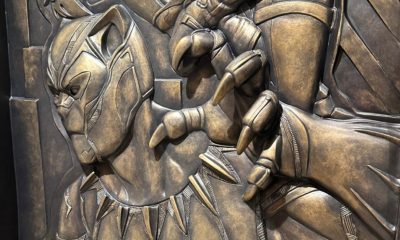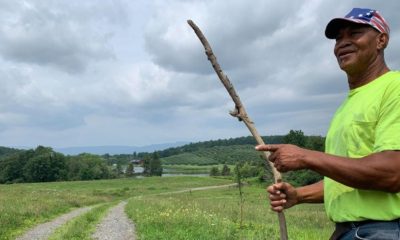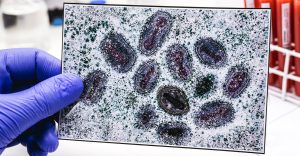Art
Artists Partner with State for “Your Actions Save Lives” Campaign
“These accomplished artists are tapping into their culture and creativity to share empowering messages with communities that have been hard hit by COVID-19,” said Chet P. Hewitt, president and CEO of the Sierra Health Foundation.

More than 20 California artists partnered with the state for the “Your Actions Save Lives” campaign. The effort was created to uplift and celebrate the resilience of communities and encourage safe practices that stop the spread of COVID-19 as Gov. Gavin Newsom plans to reopen the state on June 15.
The 14 original art projects included in the campaign range from murals, interactive exhibits, and live performances from artists based in communities highly impacted by the COVID-19, including Oakland, Sacramento, Stockton and San Diego.
“The arts have an opportunity to be uplifting and healing to your emotions,” said Jessica Wimbley, an African American digital artist who collaborated with the state for an advertisement on an Oak Park billboard in Sacramento and a digital art display at Arden Fair Mall in Sacramento.
“It’s been a breath of fresh air to work on this campaign. There’s been so much negativity and divisiveness that’s happening in the world that is heavy on the spirit,” said Wimbley.
“It’s been transformative to work on this project,” she added.
The state partnered with the Center at Sierra Health Foundation in Sacramento for the project which relies on the power of art to communicate the importance of health awareness in addition to getting vaccinated.
“These accomplished artists are tapping into their culture and creativity to share empowering messages with communities that have been hard hit by COVID-19,” said Chet P. Hewitt, president and CEO of the Sierra Health Foundation.
“Art has incredible power, and we believe these works will spark important conversations, connections, and inspiration throughout the state,” he said.
Four female artists, including Wimbley, have used the project to tap into their respective cultures to create powerful visual artworks that empower and inform their diverse communities.
The interactive installation, ‘Benevolent Animals, Dangerous Animals,’ by Masako Miki located in Oakland’s Chinatown was inspired by Japanese folklore.
Sunroop Kaur, a classical artist, whose Spring mural is located in Stockton was inspired by her Punjabi-Sikh heritage. In San Diego, the mural ‘Stop the Spread’ by Tatiana Ortiz-Rubio honors her Mexican heritage.
In addition to the art campaign, Newsom recently announced a $116.5 million incentive program that will reward people in California for getting vaccinated. The state allotted $100 million in grocery gift cards worth $50 each for the next two million people who get vaccinated.
The remaining $16.5 million will be awarded as cash prizes to people who have been vaccinated across the state. More than 17 million people in California are fully vaccinated which is about 44% of the state’s population.
The incentive program aims to encourage everyone in California to get vaccinated with a goal to reopen the state by mid-June this year.
State officials say they are determined to fully reopen California schools and businesses in efforts to help the economy recover.
Black and Brown families continue to experience the brunt of the economic blow caused by COVID-19 despite the state’s efforts for community outreach to minimize hardship in their respective communities.
The artists featured in the state’s “Your Actions Save Lives” campaign hope to communicate messages of unity and solidarity through art influenced by their different cultures.
Four local artists celebrate their heritages and draw inspiration from their multicultural communities.
Masako Miki — Oakland
The interactive art installation ‘Benevolent Animals, Dangerous Animals’ by Miki was inspired by the idea of a treasure hunt throughout Chinatown in Oakland. The pandemic forced people to stay indoors, but the public art installation encourages people to explore different shops and restaurants while admiring the art.
The artwork was inspired by shapeshifting animals in Japanese mythology.
“I wanted to make this positive and uplifting because when things are dark and difficult, we need to have more positive images,” said Miki.
The current reality of the pandemic is, “so dark and difficult that we need to have imagery that gives us the ability to envision something positive,” she said.
In Japanese culture the tiger is a majestic animal that is fearless, she says. The cultural message in the artwork echoes notions of toughness.
“Resiliency is our strength,” and the benevolent animals featured in the art are meant to encourage people to, “respect each other and have empathy to get through this difficult time together,” said Miki.
Recent incidents of violence against Asians have fueled racial tension in America, in addition to the violence toward African Americans nationwide. Miki aspires to use her artwork to dispel stigmas related to COVID-19 about the Asian community.
“We have to have this dialogue so that I can introduce my culture in such a way that it becomes familiar and it’s not something that they’re afraid of because they don’t know about it,” said Miki.
Artistic performances and visual displays created by all the artists in the “Your Actions Save Lives” campaign have been exhibited since April and will continue until June this year.
Sunroop Kaur — Stockton
Kaur, an artist of South Asian descent, aims to decolonize classical art by using people of color as the center of attention in her paintings.
The large population of Punjabi Sikh immigrants in Stockton is a major influence in Kaur’s artwork. Kaur is intentional about using people of color as the focal point in her ‘Spring’ mural located at JMP Restaurant Supply.
“This mural is a visual celebration of my community and its resilience to not only survive in a foreign land but to thrive,” said Kaur.
The mural draws from the idea of, “decentering whiteness within my work by using people of color is my main fitters,” she said.
“The appropriation of Western classical art canons as a way to decolonize my own body and my culture,” she said.
The artwork includes two people socially distancing and wearing masks depicted through the Italian Baroque portraiture, a 17th-century art style associated with grandeur, movement, and drama.
The body language from the figures symbolizes, “the universal longing and yearning we feel for one another, but also acknowledging the fact that to keep our loved ones safe,” said Kaur.
The mural also includes pastel-colored floral patterns in reference to Spring which represents the reemergence of life following the pandemic. The mural includes royal blue arches as well as pink and malachite with historical pastel pigments that are part of Persian culture.
Jessica Wimbley — Sacramento
Wimbley, a renowned African American artist, uses her digital art to empower Black people to have agency in their own lives.
The Oak Park Billboard, which is part of a state-sponsored advertising campaign, features Wimbley’s husband as the model. The representation of dark-skinned Black men is important when there have been many incidents of people dying in the media.
The billboard reinforces, “This notion of a Black man living,” said Wimbley.
“It’s really important to bring humanization to the representation of Black people in media. And focus on producing an agency, and empowerment,” she said.
Wimbley’s Masking Series was inspired by the tradition of masquerade which is celebrated in many cultures across Africa. The art series features a still photo of a face with a mask modeled by her husband and a multimedia image with a mask reflecting different visuals.
“The storytelling communicates the important occurrences within the community, I was reflecting on wearing a mask within the masquerade culture and the transformative nature of both putting on a mask and wearing one,” said Wimbley.
Wimbley also wanted to humanize Black and Brown people who were disproportionately impacted by COVID-19. The added stress of police brutality resulting in the death of African Americans nationwide also inspired Wimbley to show that Black people have agency in their own lives.
Through her art, Wimbley said that she wants Black people, “to be in a place of empowerment, versus, a space of trauma.”
“We are a part of an interconnected story and part of each other’s stories. We have agency in how we move forward, and we can write, claim, and develop what that next phase looks like,” said Wimbley.
The symbolism of the images presented on the Oak Park billboard and the digital display at Arden Fair Mall highlight different codes that have inspired social justice movements throughout the nation. On the billboard, the model is wearing a mask with coded patterns promoting vaccinations and several rings, one with Harriet Tubman.
Tatiana Ortiz-Rubio
In her ‘Stop the Spread’ mural located at Bread & Salt Gallery in Chicano Park,
Mexican-American visual artist Ortiz-Rubio used the image of a Latina woman to raise awareness on COVID-19 safety precautions in her community.
According to national data, Latinos make up about 30 % of San Diego’s population. They were disproportionately affected by COVID-19 because a disproportionate number are essential workers or undocumented people.
“This is truly a message for anyone in the world because a pandemic has affected us all. But it hasn’t affected us equally,” said Ortiz-Rubio.
“In the United States, minorities have been affected because of their race and economic status,” she said.
Muralism was a social movement which helped foster systematic change in Mexico. Ortiz-Rubio said that the Black Lives Movement also inspired her to challenge racism and inequality through her artwork.
“It speaks to everyone, and the fact that it is a Latin American woman speaking to anyone, is also important because usually generalized images are of a White person,” she said.
Being a woman is an integral part of Ortiz-Rubio’s experience creating the mural. She recalled young girls and their mothers witnessing her paint the mural from their backyards which reaffirmed her desire to use a Latina as the centerpiece of her mural.
“It’s very empowering to be celebrated,” said Ortiz-Rubio.
“This will be a message that will take that stigma away,” she said.
The visual artist said that she wants Latin Americans to be represented and celebrated in her art especially when they are the target audience.
California Black Media’s coverage of COVID-19 is supported by the California Health Care Foundation.
Activism
‘I Was There Too’ Reveals the Hopes, Dangers of Growing Up in The Black Panther Party
On July 20, at the Oakland Museum of California’s Spotlight Sundays, Gabriel, the daughter of a Black Panther Party couple, Emory Douglas, minister of culture, and artist-educator, Gayle Asalu Dickson, gave a raw personal view of being raised in the middle of the Black Power Movement.
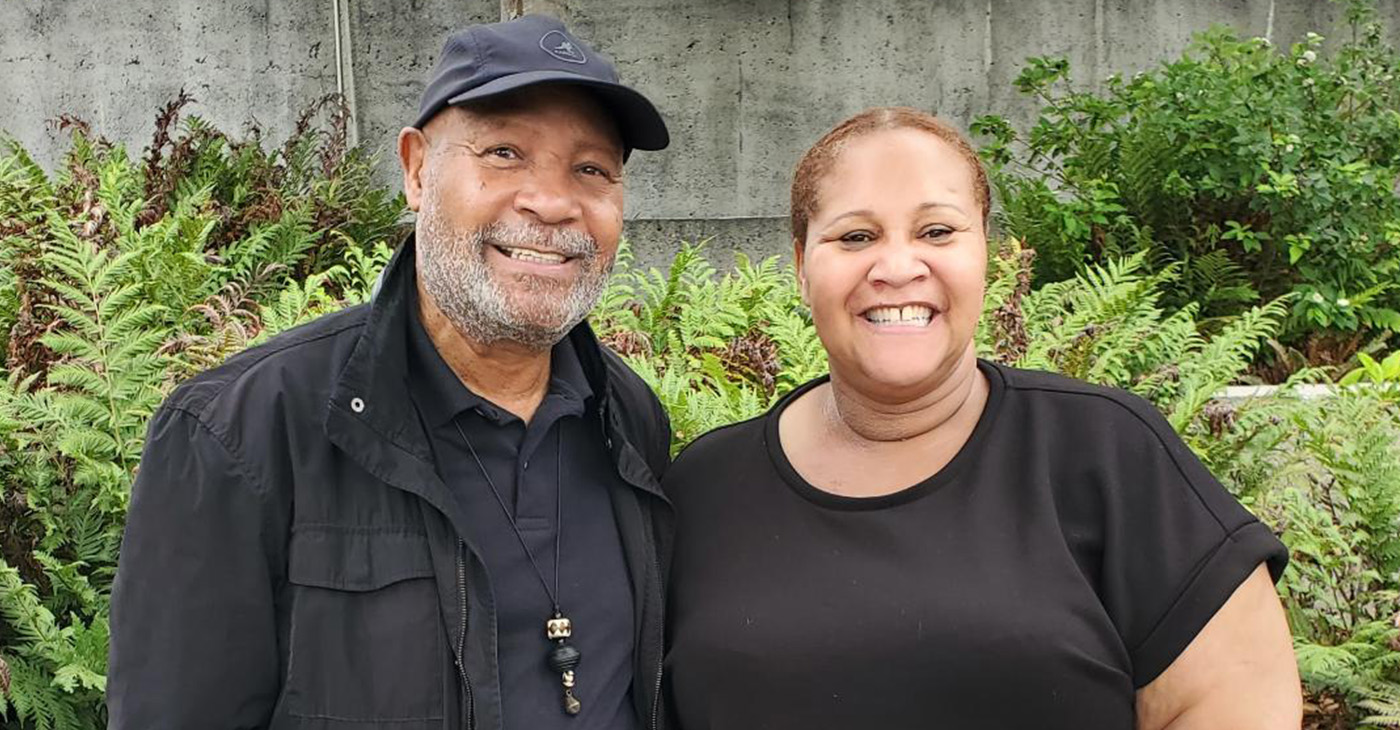
By Carla Thomas
Chronicles of the Black Panther Party are often shared from the perspectives of Huey Newton, Bobby Seale, Angela Davis, or Kathleen Cleaver. However, the view from a Panther’s child was unique on stage as Meres-Sia Gabriel performed, “I Was There Too.”
On July 20, at the Oakland Museum of California’s Spotlight Sundays, Gabriel, the daughter of a Black Panther Party couple, Emory Douglas, minister of culture, and artist-educator, Gayle Asalu Dickson, gave a raw personal view of being raised in the middle of the Black Power Movement.
Gabriel took the audience on her tumultuous journey of revolution as a child caught between her mother’s anger and her father’s silence as the Party and Movement were undermined by its enemies like the COINTELPRO and the CIA.
Gabriel remembers her mom receiving threats as the Party unraveled and the more lighthearted moments as a student at the Black Panther Party’s Community School.
The school was a sanctuary where she could see Black power and excellence in action.
It was there that she and other children were served at the complimentary breakfast program and had a front row seat to the organization’s social and racial justice mission, and self-determination, along with the 10-point platform where the party fought for equality and demanded its right to protect its community from police brutality.
On her journey of self-development, Gabriel recounted her college life adventures and transformation while immersed in French culture. While watching television in France, she discovered that her father had become a powerful post-revolution celebrity, sharing how high school and college-age youth led a movement that inspired the world.
Through family photographs, historical images projected on screen, personal narratives, and poetry, Gabriel presented accounts worth contemplating about the sacrifices made by Black Panther Party members. Her performance was backed by a jazz trio with musical director Dr. Yafeu Tyhimba on bass, Sam Gonzalez on drums, and pianist Sam Reid.

At the Oakland Museum of California, Amy Tharpe, Ayanna Reed, artist Meres-Sia Gabriel and Kenan Jones at the meet-and-greet after the “I Was There Too” multimedia production. Photo by Carla Thomas.
Gabriel’s poetry is featured in the “Black Power” installation at the Oakland Museum of California, and her father’s book, “Black Panther: The Revolutionary Art of Emory Douglas,” features her foreword. She accompanied her father on tour exhibiting his artwork from the Panther Party’s publication as Minister of Culture.
Gabriel considers her work as a writer and performer a pathway toward self-reflection and personal healing. While creating “I Was There Too,” she worked for a year with the production’s director, Ajuana Black.
“As director, I had the opportunity to witness, to create, to hold space with tenderness and trust,” said Black. “Her performance touched my soul in a way that left me breathless.”
With over two decades of musical theater experience, Black has starred in productions such as “Dreamgirls” as Lorrell and “Ain’t Misbehavin’s” Charlene. She also performs as the lead vocalist with top-tier cover bands in the Bay Area.
During the post-performance meet-and-greet in the (OMCA) Oakland Museum of California garden, Gabriel’s father posed for photos with family and friends.
“I am proud of her and her ability to share her truth,” he said. “She has a gift and she’s sharing it with the world.”
Shona Pratt, the daughter of the late BPP member Geronimo Pratt, also attended to support Gabriel. Pratt and Gabriel, known as Panther Cubs (children of the Black Panther Party), shared their experience on a panel in Richmond last year.
“Meres-Sia did a great job today,” said Pratt. “It was very powerful.”
Meres-Sia Gabriel was born and raised in Oakland, California. A graduate of Howard University in Washington, D.C., and Middlebury College School in France, Gabriel serves as a French instructor and writing coach.
Activism
The Past and Future of Hip Hop Blend in Festival at S.F.’s Midway
“The Music and AI: Ethics at the Crossroads” panel featured X.Eyee, CEO of Malo Santo and senior advisor for UC Berkeley’s AI Policy, Sean Kantrowitz, director of media and content @Will.I.A.’s FYI, Adisa Banjoko of 64 Blocks and Bishop Chronicles podcast, and Julie Wenah, chairwoman of the Digital Civil Rights Coalition.
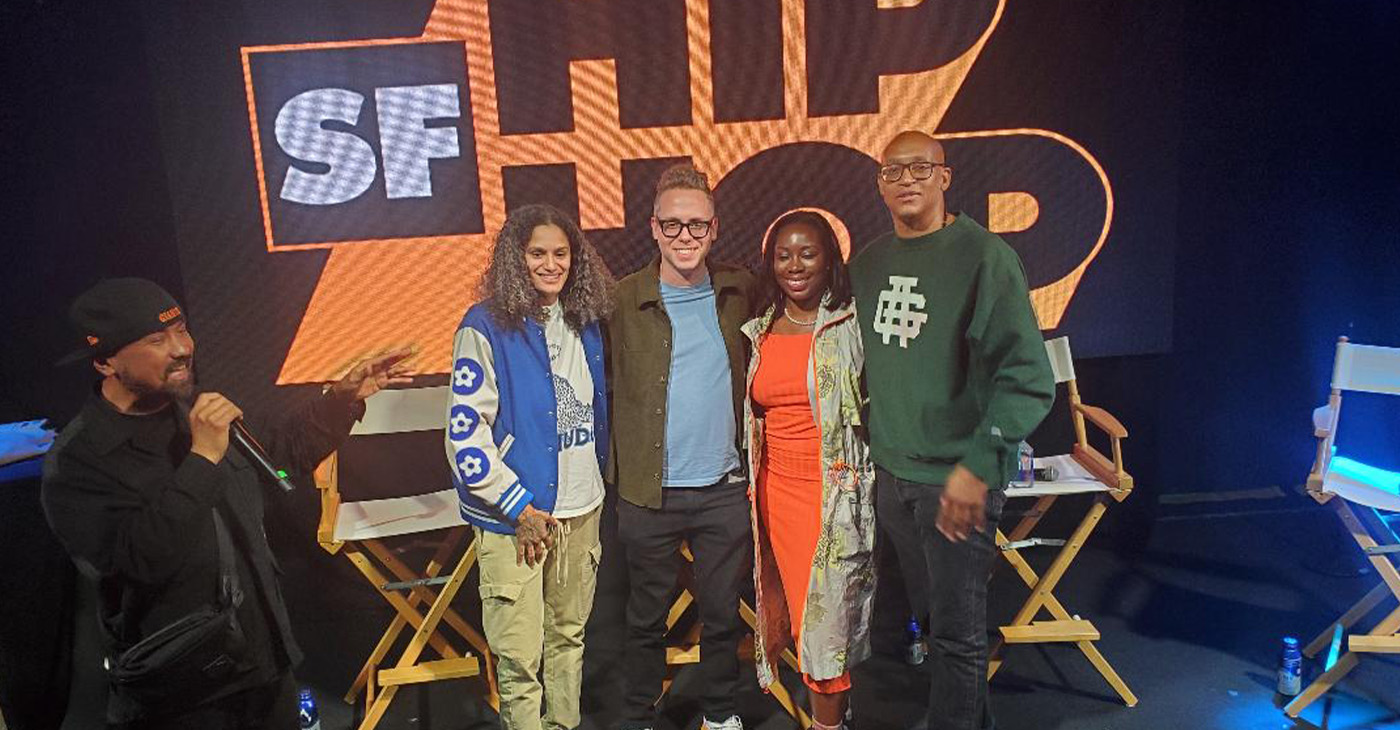
By Carla Thomas
“Cultural Renaissance,” the first-ever SF Hip-Hop conference, occurred at The Midway at 900 Marin St. in San Francisco on July 18 and 19. Held across three stages, the event featured outdoor and indoor performance spaces, and a powerful lineup of hip-hop icons and rising artists.
Entertainment included Tha Dogg Pound, celebrating their 30th anniversary, Souls of Mischief, and Digable Planets. “Our organization was founded to preserve and celebrate the rich legacy of Hip-Hop culture while bringing the community together,” said SF Hip-Hop Founder Kamel Jacot-Bell.
“It’s important for us to bring together artists, innovators, and thought leaders to discuss how hip-hop culture can lead the next wave of technological and creative transformation,” said Good Trouble Ventures CEO Monica Pool-Knox with her co-founders, AJ Thomas and Kat Steinmetz.
From art activations to cultural conversations, the two-day event blended the intersections of AI and music. Panels included “Creative Alchemy – The Rise of the One-Day Record Label,” featuring producer OmMas Keith, composer-producer Rob Lewis, AI architect-comedian Willonious Hatcher, and moderator-event sponsor, AJ Thomas.
“The Legends of Hip-Hop and the New Tech Frontier” panel discussion featured hip-hop icon Rakim, radio personality Sway, chief revenue officer of @gamma, Reza Hariri, and music producer Divine. Rakim shared insights on culture, creativity, and his A.I. start-up NOTES.
“AI is only as good as the person using it,” said Rakim. “It cannot take the place of people.”
Rakim also shared how fellow artist Willonious helped him get comfortable with AI and its power. Rakim says he then shared his newfound tool of creativity with business partner Divine.
The panel, moderated by the Bay Area’s hip-hop expert Davey D, allowed Divine to speak about the music and the community built by hip-hop.
“Davey D mentored me at a time when I had no hope,” said Divine. “Without his support, I would not be here on a panel with Rakim and Willonious.”
Hatcher shared how his AI-produced BBL Drizzy video garnered millions of views and led to him becoming one of Time magazine’s 100 most influential AI creators.
“The Music and AI: Ethics at the Crossroads” panel featured X.Eyee, CEO of Malo Santo and senior advisor for UC Berkeley’s AI Policy, Sean Kantrowitz, director of media and content @Will.I.A.’s FYI, Adisa Banjoko of 64 Blocks and Bishop Chronicles podcast, and Julie Wenah, chairwoman of the Digital Civil Rights Coalition.
“Diverse teams solve important questions such as: ‘How do we make sure we bring diverse people to the table, with diverse backgrounds and diverse lived experiences, and work together to create a more culturally sound product,’” said Wenah.
Self-taught developer, X.Eyee said, “You have to learn the way you learn so you can teach yourself anything. Future jobs will not be one roadmap to one individual skill; you will be the orchestrator of teams comprised of real and synthetic humans to execute a task.”
Activist Jamal Ibn Mumia, the son of political prisoner Mumia Abu Jamal, greeted Black Panther Party illustrator Emory Douglas, who was honored for his participation in the Black Power Movement. Douglas was presented with a statue of a black fist symbolizing the era.
“It’s an honor to be here and accept this high honor on behalf of the Black Panther Party,” said Douglas, holding the Black Power sculpture. “It’s an art (my illustrations) that’s been talked about. It’s not a ‘me’ art, but a ‘we’ art. It’s a reflection of the context of what was taking place at the time that inspired people.
“To be inspired by is to be in spirit with, to be in spirit with is to be inspired by, and to see young people continue on in the spirit of being inspired by is a very constructive and powerful statement in the way they communicate,” Douglas said.
His work embodied the soul of the Black Panther Party, and as its minister of culture and revolutionary artist, he definitely keeps the Panther Party soul alive, and his work is everywhere.
“Brother Emory Douglas is an icon in the community,” said JR Valrey of the Block Report.
“Fifty years later, he’s still standing,” said Ibn Mumia, raising his fist in the traditional Black Power salute.
“Emory is a living legend and so deserving of this award,” Valrey said. “We have to honor our elders.”
Activism
Mayor Lee’s Economic Development Summit at Oakstop Furthers Creative Strategies for Oakland’s Future
Oakstop’s workforce development initiative, “The Oakstop Effect: WFD,” focuses on providing pathways to employment and advancement for Black adults aged 18–64. Through culturally relevant, mission-driven training facilitated by Black professionals with relatable backgrounds, the program creates supportive environments for skill-building, wealth creation, and worker empowerment.

By Carla Thomas
On Monday, Aug. 4, Oakland Mayor Barbara Lee convened the Mayor’s Economic Development Working Group at Oakstop, drawing leaders from business, workforce development, arts and culture, education, small business, and community organizations.
This initiative builds on the administration’s deep-rooted community engagement efforts, expanding on the dozens of roundtables and listening sessions conducted during Lee’s first 76 days in office.
The collaborative session aimed to shape an economic strategy rooted in equity, creativity, and community using the mayor’s five-point economic plan, including empowering small businesses, strengthening the local workforce, revitalizing Oakland’s cultural and social landscape, attracting and retaining strategic sectors, and ensuring economic opportunity for all communities.
During breakout sessions, participants shared recommendations across five focus areas: economic policy, small business support, workforce development, narrative change, and integration of arts and culture.
More than 100 participants at the meeting, which included former Alameda County Supervisor Keith Carson, Black Cultural Zone CEO Carolyn Johnson, East Oakland Youth Development Center CEO Selena Wilson, African American Sports and Entertainment Group founder, Ray Bobbitt, Executive Director of the Oakland School for the Arts Mike Oz, Visit Oakland Executive Director Peter Gamez and activist-artist Kev Choice.
“Our economic development working group aims to spark collaboration, uplift existing successes, and identify what’s needed to keep The Town open for business — vibrant, safe, and rooted in equity,” said Lee remarked at the gathering.
Oakstop founder and CEO Trevor Parham stated that the summit felt like an open community forum. “It’s critical to have as many perspectives as possible to drive solutions so we can cover not only our concerns, but fulfill our economic mission,” said Parham.
Parham says the community should expect summits and collaborations more often at Oakstop. “I’m excited about the prospects and the outcomes from bringing people from different industry sectors as well as different levels.”
Oakstop’s workforce development initiative, “The Oakstop Effect: WFD,” focuses on providing pathways to employment and advancement for Black adults aged 18–64. Through culturally relevant, mission-driven training facilitated by Black professionals with relatable backgrounds, the program creates supportive environments for skill-building, wealth creation, and worker empowerment.
“Our goal is to foster worker power for local workers, to build wealth, while building skills and redefining the workplace,” said Parham.
The program is powered through partnerships with organizations such as Philanthropic Ventures Foundation and Community Vision. Beyond workforce development, Oakstop offers co-working spaces, event venues, art galleries, and mental health and wellness programs — reinforcing its mission of community empowerment and economic mobility.
With a strategic equity framework, cultural and economic integration, and a continuous pipeline of sustainable talent, Lee plans to revitalize the Oakland economy by creating policies and opportunities that stabilize the city.
-

 #NNPA BlackPress4 weeks ago
#NNPA BlackPress4 weeks agoLIHEAP Funds Released After Weeks of Delay as States and the District Rush to Protect Households from the Cold
-
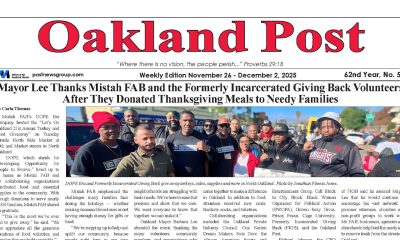
 Activism4 weeks ago
Activism4 weeks agoOakland Post: Week of November 26 – December 2, 2025
-

 Alameda County3 weeks ago
Alameda County3 weeks agoSeth Curry Makes Impressive Debut with the Golden State Warriors
-

 #NNPA BlackPress4 weeks ago
#NNPA BlackPress4 weeks agoSeven Steps to Help Your Child Build Meaningful Connections
-

 #NNPA BlackPress4 weeks ago
#NNPA BlackPress4 weeks agoSeven Steps to Help Your Child Build Meaningful Connections
-
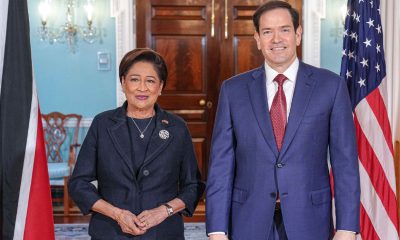
 #NNPA BlackPress4 weeks ago
#NNPA BlackPress4 weeks agoTrinidad and Tobago – Prime Minister Confirms U.S. Marines Working on Tobago Radar System
-

 #NNPA BlackPress4 weeks ago
#NNPA BlackPress4 weeks agoThanksgiving Celebrated Across the Tri-State
-
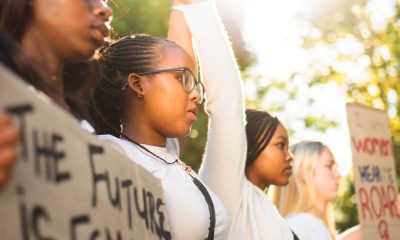
 #NNPA BlackPress4 weeks ago
#NNPA BlackPress4 weeks agoTeens Reject Today’s News as Trump Intensifies His Assault on the Press





